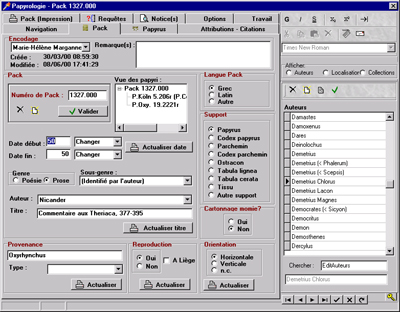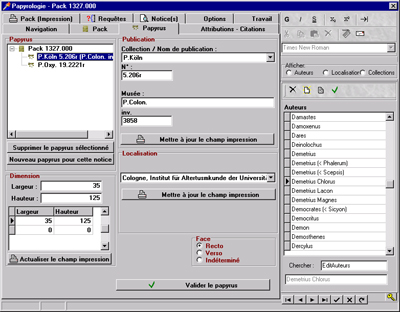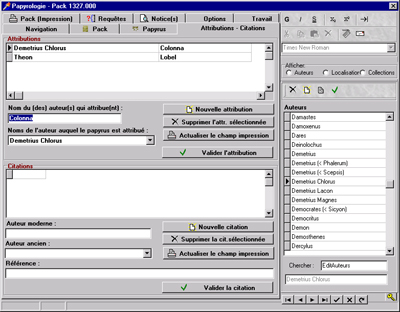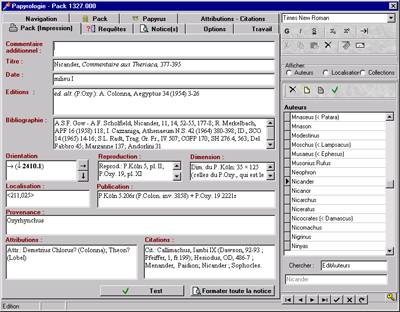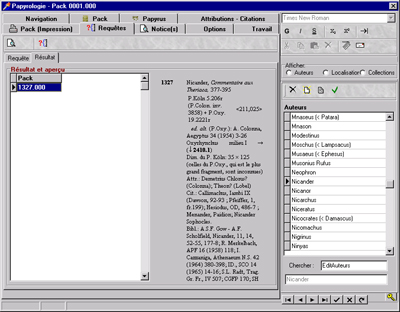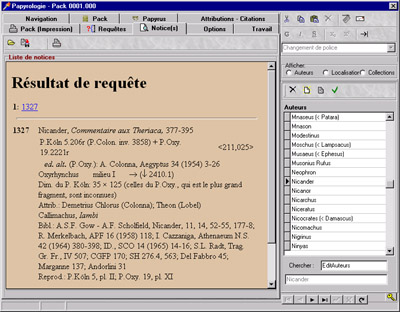Archives
The Mertens Pack³ database project (1999-2013)
The Pack entry
Papyri
Attributions and quotations
Filling out entries
The search module
Search results
A complete entry
And later ?
The computerisation project for the Mertens-Pack³ file was thus launched in 1999 and is now proceeding, co-ordinated by Marie-Hélène Marganne, of CEDOPAL. In charge of its realisation is Denis Renard, at the Centre Informatique de Philosophie et Lettres (CIPL) (Philosophy and Letters Computer Centre) at the University of Liège. The aim of this collaboration is to design a programme for storing and exploiting the rich information assembled in the last thirty or so years for the third edition of the Catalogue des papyrus littéraires grecs et latins or Mertens-Pack³.
The system has been designed with regard to the structure of information and the conventions in force for the constitution of ” Pack ” entries.
The central element of the database set up in the framework of this project is the Pack.
Each Pack entry is identified notably under :
- a single number for each entry, a number which, by a decimal system, respects the initial numbering and arrangement of Pack² ;
- a dating (in the form of an interval) ;
- language (Greek, Latin, other) ;
- author ;
- title ;
- genre (prose, poetry, literary genre) ;
- orientation of the fibres ;
- re-use (is it a mummy-cartonnage ?) ;
- support (volumen or codex on papyrus or parchment, wax-covered tablet, …) ;
- existence of a reproduction in Liège or elsewhere ;
- place and circumstances of discovery or first mention (examples : discovery-Fayoum ; purchase-Cairo).
Each entry in this table is linked to :
- one or several entries in a table which may describe each of the papyri belonging to the same bibliological entity (see below Papyrus tab) ;
- one or several entries in a table detailing the quotations from classical authors in the bibliological entity described by the Pack entry (see below Quotations/Attributions tab) ;
- one or several entries in a table detailing attributions to classical authors proposed by modern authors for each of the Pack entries (see below Quotations/Attributions tab) ;
- one or several entries in a table which will contain iconographic data : example of writing, details, copyright, etc. ;
- an entry in a table of authors for whom the Latin form of the name has been conventionally chosen.
It happens fairly often that papyri earlier forming part of the same roll or codex are found in different public or private collections. In order to preserve the trace of each of these fragments, archived information gives :
- the name of the papyrus according to edition (collection/publication) and the classification number in the latter ;
- the name of the papyrus according to its conservation site, possibly with its inventory number ;
- the location ;
- the dimensions in millimetres of the largest fragment.
Remarks :
- the name of the collection may be simply a publication name (for example P.Oxy.) ;
- a still unedited papyrus may have a “museum” name but not a publication name. An edited papyrus may only be known under its collection or publication name. It may also be listed in a collection and at the same time in an inventory ;
- locations and collections are in separate tables in which entries can be added, suppressed or modified.
For each Pack entry it is possible to preserve the trace of the relevant attributions and quotations. In this example the text was attributed by Colonna to Demetrius Chlorus and by Lobel to Theon. The quotations are encoded as follows : classical author and his reference, possibly with edition indications in the “Modern author” area of the tab.
In this part of the program, the encoder has to complete the entry by introducing new data. Most of the fields are composed automatically from information already provided by the encoder (title, date, orientation, reproduction, dimension [of the largest conserved fragment], location, publication, origin, attributions, quotations) and are completed or nuanced at this stage of the work, whereas the fields concerning editions and bibliography are completely encoded in this same tab.
For the purposes of edition, the text to be inserted may be given formal attributes, either simple (bold, italic, underlined) or more complex, such as sets of Greek characters, with or without a table of characters.
When the encoding module proved sufficiently complete and reliable, the question arose concerning the queries a user should be able to make to the data-base. Here are all the possibilities at present offered by the system’s search module. The search criteria, which can be used concurrently, are as follows :
- encoder (useful particularly for the development of the system) ;
- language (Greek, Latin, other) ;
- author ;
- date (defining a post quem terminus, an ante quem terminus or an interval) ;
- genre (prose ? poetry ?) ;
- sub-genre (comedy, biography, medicine, pedagogic exercises, etc.) ;
- mummy-cartonnage (boolean/logical field) ;
- support (selected from a list of possible values) ;
- orientation of the fibres ;
- location;
- collection ;
- attribution (by classical author only) ;
- quotation (by classical author only) ;
- dimension.
The example here illustrates a query concerning the author Nicander, represented by papyrological witnesses anterior to 100 AD in the P.Oxy. publications.
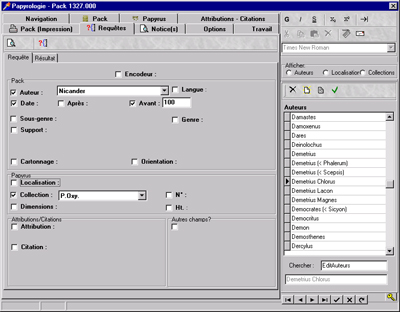
Here are some other searches that can at present be carried out :
- the papyri used for mummy-cartonnage in the III century BC ;
- the papyri with Hesiod as author ;
- the papyri in which are found quotations from Hesiod ;
- the papyri that have ever been attributed to Hesiod ;
- the medical treatises anterior to Galien’s floruit ;
- etc.
In the near future, this search module will be completed by certain query fields and enhanced by the possibilities offered by the use of logical operators and sorting directives. Other queries could then be considered, such as :
- the papyri with Hesiod as author or which have ever been attributed to him ;
- the papyri discovered on a particular site, grouped according to the orientation of fibres and with a sample of writing for each ;
- the papyri with Galien as author, sorted according to place of conservation and date ;
- the pedagogic and writing exercises, sorted according to language and support ;
- etc.
The result of the query is presented in the form of a survey. On the left, a list of entry numbers answering the query. The query shown as example produces, in the present state of the data-base, a single occurrence. On the right, a view of the entry selected in the list on the left.
One click of the mouse activates the constitution of a list in hypertext covering all the results produced. At this stage, a print-out is possible of the list of entries, which conform to the usual presentation-mode of the Mertens-Pack catalogue. The grouped entries sent on conclusion of the research are presented in the same way as the individual entries that can be read. In addition, we plan to provide this result presentation module with advanced sorting and navigational functionalities. The entries produced are already in a format which would allow a part of the catalogue to go online.
Since the beginning of this enterprise, the main criterion is flexibility. The database and the programme had not only to be adapted to existing information but to take into account every possibility of evolution involving new discoveries. The database today comprises about 3.500 entries, and will be constantly augmented in order to contain the whole Mertens-Pack entries, with a view to the publication and placing online of the third version of the file. We hope finally to be able to provide visitors to this site with the possibility to make queries themselves and thus offer a very high-level research tool to all papyrologists.
Denis Renard (July 2001)


